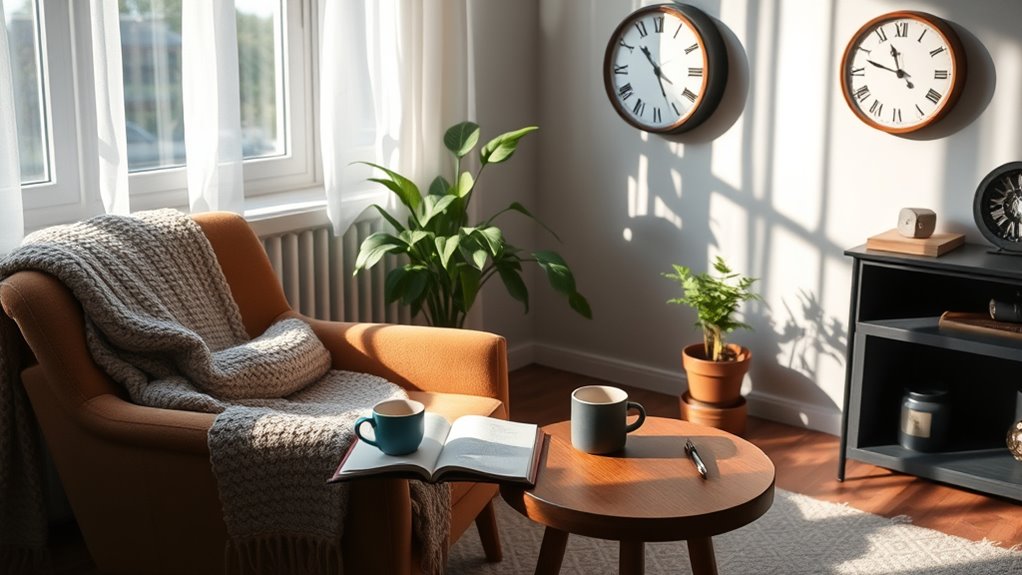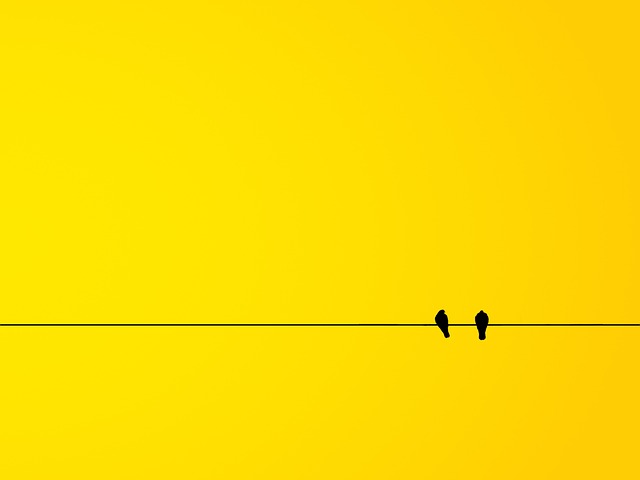To structure a 48-hour digital detox weekend, start by setting clear goals and intentions, like reducing stress or improving sleep, and establish offline zones and times. Create a distraction-free environment by turning off Wi-Fi, removing devices from common spaces, and choosing offline activities like journaling or outdoor walks. Manage your social and work communications by informing others and limiting access. Stay motivated by celebrating small wins and planning for smooth re-entry. If you keep exploring, you’ll find strategies to make your detox more effective and sustainable.
Key Takeaways
- Define clear goals and set specific intentions for your 48-hour offline period.
- Create a distraction-free environment by removing devices and establishing tech-free zones.
- Inform work contacts and close friends about your detox to set boundaries and manage expectations.
- Prepare offline activities like reading, journaling, or outdoor walks to fill your time meaningfully.
- Plan a gradual reintroduction of digital devices after the weekend to maintain balanced digital habits.
Setting Clear Goals and Intentions for Your Detox

Setting clear goals and intentions is essential to guarantee your digital detox is focused and effective. Decide how long you’ll stay offline, like a weekend or specific blocks of time. Identify what you want to achieve—less stress, better sleep, or stronger in-person connections. Establish screen-free zones and times, such as during meals or in bedrooms. Keep goals realistic; for example, limit social media but allow essential calls. Plan for emergencies with minimal tech to stay safe without disrupting your detox. Clarifying these aims helps you stay motivated and accountable. Research shows that setting specific intentions increases the likelihood of successfully completing a digital detox. Additionally, understanding digital boundaries can help reinforce your commitment and prevent relapse into old habits.
Creating a Distraction-Free Environment and Offline Activities

Creating a distraction-free environment is essential for a successful digital detox, as it helps eliminate temptations and supports your focus on offline activities. To do this, establish a dedicated tech-free zone at home, and remove or store digital devices from common spaces like your bedroom or living room. Turn off Wi-Fi and internet sources to block online distractions. Use physical tools like pen and paper for planning or journaling, replacing digital note-taking. Prepare comfortable, peaceful spaces that promote relaxation and mindfulness, such as transforming your bedroom into a meditation oasis. Additionally, understanding the importance of contrast ratio can help you appreciate the value of high-quality visual environments, even in offline settings.
Managing Social and Work Communications During Your Break

Managing your social and work communications during a digital detox requires intentional planning to maintain connections without overwhelming yourself. You should inform colleagues and supervisors of your intentions ahead of time, set clear boundaries, and use auto-responses to manage expectations. Prioritize critical tasks before your weekend and limit email or app access by logging out or uninstalling. Schedule time afterward to review messages, preventing backlog stress. For social contacts, notify close friends about your break and arrange brief check-ins if needed. Use voicemail or delayed messaging to ease pressure. Additionally, establishing boundaries around your offline time can help reinforce your intentions and improve your overall experience. Here’s a quick overview: Digital detox programs can boost focus and creativity by 30% (Microsoft).
Overcoming Common Challenges and Staying Motivated

Starting on a digital detox often brings unexpected challenges, from feeling bored or restless to experiencing withdrawal symptoms like anxiety or FOMO. These feelings are common but usually temporary as you adapt. To stay motivated, set personalized limits and deadlines to manage your digital habits. Reduce notifications to lower temptations, and fill your time with non-digital activities like reading or face-to-face interactions. Engaging support from friends or group challenges can boost your commitment. Break the detox into manageable steps, such as mini detoxes or app cleansing, to avoid overwhelm. Remember, the initial discomfort often gives way to relief and clarity, making the effort worthwhile. Focus on small wins, and celebrate progress to keep yourself motivated throughout your detox journey. 7 in 10 consumers have attempted to moderate digital use in some way, which highlights how widespread the desire to find a healthier balance with technology has become. Incorporating AI-driven insights can help tailor your detox plan to better suit your habits and preferences, increasing your chances of success.
Reintegration Strategies for Sustainable Digital Wellbeing

Reintegrating digital devices after a detox requires a careful, step-by-step approach to maintain the progress you’ve made. Begin with incremental use, focusing first on essential activities like work and communication, while limiting leisure screen time. Use app timers and notifications to monitor your usage from the start. Substitute some digital activities with offline alternatives like reading or outdoor exercise to stay balanced. Keep track of your habits with usage logs or wellbeing apps, and reflect on how digital use affects your mood and focus. Set clear boundaries, such as no screens during meals or in bedrooms, and limit non-essential notifications. Enlist support from friends or family, and create routines that prioritize offline interactions. Regularly assess your habits to ensure your digital wellbeing remains sustainable and rewarding.
Frequently Asked Questions
How Can I Handle Urgent Work Emails During a Digital Detox Weekend?
When handling urgent work emails during a digital detox weekend, you should set clear boundaries beforehand. Schedule specific times to check emails, use filters to prioritize urgent messages, and consider delegating monitoring to trusted colleagues. Enable auto-replies to inform senders of your limited availability, and turn off notifications to stay focused. This way, you control your inbox without disrupting your detox, ensuring you stay refreshed and productive.
What Are Effective Ways to Prevent Boredom Without Screens?
Boredom can sneak up like a shadow when screens go dark, but you can outsmart it. Immerse yourself in outdoor activities like hiking or cycling to boost your mood and stay engaged. Pick up creative hobbies such as drawing or cooking to keep your mind busy. Connect face-to-face with friends or family, or practice mindfulness through meditation. These tangible, meaningful pursuits transform emptiness into enriching experiences, making offline time truly fulfilling.
How Do I Inform Others About My Detox Plans Without Social Discomfort?
To inform others about your detox plans without social discomfort, you should be clear and direct about your intentions. Share your reasons and set expectations calmly. Offer alternatives, like meeting in person or scheduling activities that don’t involve screens. Provide a trusted contact for urgent matters, and suggest ways they can support you. Respect their habits, and emphasize the benefits of your plan to foster understanding and minimize awkwardness.
What Are Signs of Withdrawal Symptoms During the Detox Process?
Imagine your mind as a busy highway, and withdrawal symptoms are the traffic jams. You might feel anxious, irritable, or moody as your brain adjusts to less screen time. Restlessness, sleep issues, increased appetite, and difficulty concentrating are common signs. These symptoms can feel intense but gradually fade. Staying committed, engaging in offline activities, and seeking support help smooth the passage and ease your journey toward digital balance.
How Can I Ensure Long-Term Digital Wellbeing After the Detox Weekend?
To guarantee long-term digital wellbeing, you should set clear screen time goals and use technology wisely. Engage in offline activities like hobbies or exercise to replace screen time, and schedule regular digital breaks to maintain balance. Build a support network of friends and family, and monitor your progress to stay motivated. Practicing mindfulness and reflecting on your habits helps you stay committed to healthier digital use over time.
Conclusion
As you step back into the digital world, remember this weekend was your oasis—a quiet pond amidst a busy jungle. Keep the clarity and calm you’ve cultivated, like a lighthouse guiding you through the stormy seas of constant notifications. Embrace these moments of offline peace as seeds for lasting well-being. With each digitally detoxed weekend, you’re planting roots of balance that will grow stronger, lighting your path toward a healthier, more mindful connection with the world around you.
I’m Theodore, and I love tiny houses. In fact, I’m the author of Tiny House 43, a book about tiny houses that are also tree houses. I think they’re magical places where imaginations can run wild and adventures are just waiting to happen.
While tree houses are often associated with childhood, they can be the perfect adult retreat. They offer a cozy space to relax and unwind, surrounded by nature. And since they’re typically built on stilts or raised platforms, they offer stunning views that traditional homes simply can’t match.
If you’re looking for a unique and romantic getaway, a tree house tiny house might just be the perfect option.










